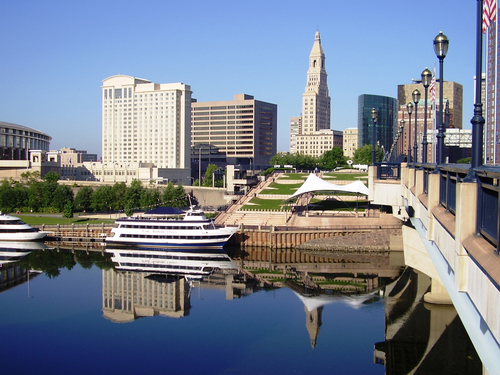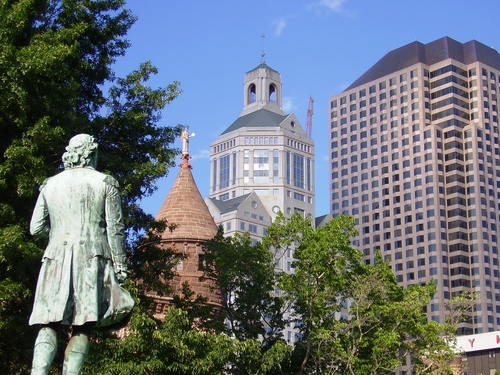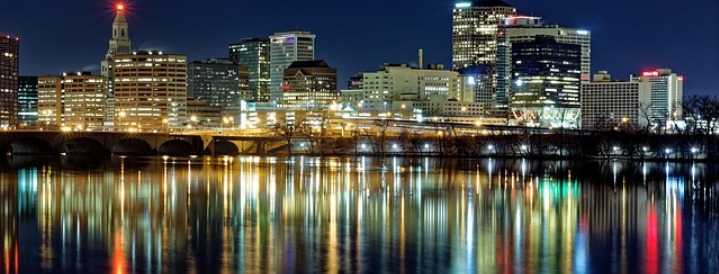2024 Hartford Visitors Guide
One of America’s first cities, Hartford was founded by Dutch traders in the early 1600s and officially established by the Reverend Thomas Hooker in 1636. As the capital of Connecticut, it is strategically located in the center of the state near the Connecticut River. Hartford is often referred to as the “Insurance Capital of the World” since several insurance companies are headquartered here, and because the industry dominates the region.

The 2000 census indicated that the population was 121,578, but a 2002 Census estimate placed the city’s population at 124,558. The racial makeup of the city was 17.72% White, 38.05% Black or African American, 0.54% Native American, 1.62% Asian, 0.11% Pacific Islander, 26.51% from other races, and 5.44% from two or more races. 40.52% of the population was Hispanic or Latino of any race.
The median income for a household in the city was $24,820, and the median income for a family was $27,051. The per capita income for the city was $13,428.
Hartford Attractions
The Cathedral of Saint Joseph is known for its huge expanse of spectacular stained glass windows crafted in Paris, a ceramic tile mural behind the altar that is the largest of its kind in the world, and its majestic four manual Austin pipe organ. The cathedral serves as a repository for some of the most outstanding examples of contemporary ecclesiastical art – in stained glass, mosaics, and sculpture, in both metal and stone.

The Mark Twain House was the home of author Mark Twain from 1871-1891. The architectural style of the 19-room house itself is Victorian Gothic. Prior to be declared a National Historic Landmark in 1974, it functioned as a school, an apartment building and a library since. The home has since undergone a multi-million dollar renovation and expansion dedicated to showcasing Mark Twain’s life and work.
Art lovers and history buffs will love the Wadsworth Atheneum. The museum is the oldest public art museum in the U.S and is home to approximately 50,000 objects spanning more than 5,000 years of world history.
Hartford Recreation
Hartford’s proximity to the Connecticut River makes it great for fishing. The city’s fifty public parks and squares cover more than 27,000 acres and host numerous outdoor sports and recreation programs.
Bushnell Park boasts a 1914 carousel with a Wurlitzer organ and 48 intricately carved and painted wooden horses. Designed by a renowned landscaper, Frederick Law Olmstead, the park is believed to be America’s oldest public park. If you literally want to stop and smell the roses, then you will love the Elizabeth Park Rose Gardens which contains thousands of common and rare plants and roses, viewable in landscaped beds and in greenhouses.
Spectator sports fans can watch the Hartford FoxForce, part of the World Team Tennis (WTT) Pro League, features tennis as you’ve never seen it. Or, the Hartford Wolf Pack, a professional hockey team and AHL affiliate of the New York Rangers.
Hartford Arts
Hartford Stage is internationally recognized for producing a wide range of the best of world drama, from classics to provocative new plays and musicals and neglected works from the past. Marking its 63rd season in 2006-2007, the Hartford Symphony Orchestra is Connecticut’s premier musical organization and is widely recognized as one of America’s leading regional orchestras. The Connecticut Opera Association puts on four annual productions and features some of the finest voices in the world.
Hartford Dining
The restaurants in Hartford reflect the city’s multiethnic make-up. Diners can choose from a wide array of food ranging from French continental to Scandinavian, German, Polish, and Italian. Asian cuisine and foods from Puerto Rico are also popular.
Bin228 is a causal and funky restaurant with a cozy urban vibe and fabulous bar. Specials like beef carpaccio and coppa paninis are highly recommended.
With the warm feel of a family operation, Casa Lisboa is a charming find for the diner who wants a more ethnic flavor. The restaurant has been serving up Portuguese delights for over 30 years. Costa Del Sol Restaurant is a contemporary and elegant restaurant offering a menu known for its seafood and for incorporating Spanish and South American flavors.
With choices like jerk chicken and spicy beef patties, it’s hard to decide what to eat at Island Cuisine.
Described as relaxed, classy and clean, McKinnon’s is an authentic Irish eatery offering up classic choices such as corned beef, Reuben sandwiches and Shepherd’s pie.
Tapas on Ann is a funky martini bar with healthy food such as hummus platters, kettle made soups, flatbread pizzas, burgers and delicious gyros.
Hartford Communities
Hartford is comprised of 17 neighborhoods including Asylum Hill, Barry Square, Behind the Rocks, Blue Hills, Clay/Arsenal, Downtown, Frog Hollow, North East, North Meadows, Parkville, Sheldon/Charter Oak, South Green, South Meadows, South End, South West, Upper Albany, and West End.
Asylum Hills was a prominent residential district in the 1840s as wealthy families sought more spacious homes outside of the city. Throughout the 19th century, impressive homes were constructed, many of which remain today.
Barry Square has a good mix of residential and complimenting commercial properties. The residents of Barry Square are a multicultural mix who enjoy the community atmosphere of their community.
Also known as Charter Oak-Zion, Behind the Rocks was named for the rocky outcropping that serves as the western border of the Trinity College campus. At the turn of the 20th century, trolley lines first opened up this neighborhood for residential development.
Located in the northeast corner of Blue Hills is a large percentage of the campus of the University of Hartford. The University is an active and important member of the neighborhood.
Clay Arsenal is one of Hartford’s oldest neighborhoods, developed in the middle and late 19th century. After World War II, the area became popular with working-class Puerto-Rican families who had come to work in the tobacco fields.
Frog Hollow takes its name from the marshy conditions in the low land areas. Ethnic groups calling the neighborhood home have been diverse. They have included Swedish, Danish, German, Irish, French Canadian, Greek and Puerto Rican.
The North East neighborhood is bounded by Spring Grove Cemetery to the south, the railroad yards to the east, and Keney Park to the north and west. Since the 1890s the neighborhood has been primarily residential, with small tradespeople.
The North Meadows has become a center for business and industry, with large parcels of land, and convenient access to Interstate 91 and Downtown Hartford. The Sheldon/ Charter Oak neighborhood is significant to Hartford’s history as it was the site of the original colonial settlement in 1623.
The early population of Park Hallow was mainly comprised of working-class Irish, French Canadian, Scandinavian and German. Today, the neighborhood has of a large population of Portuguese.
The South Green neighborhood is adjacent to Downtown’s southern border. Congress Street is a historic district listed on the National Register of Historical Places. Greek Revival and Italianate buildings line both sides of the street, accommodating both residential and commercial uses.
The South Meadows is an industrial and commercial area in the southeast section of Hartford. Adjacent to the Connecticut River, it has a variety of private industrial, commercial, and wholesale businesses.
The South End neighborhood grew rapidly after World War I. The area along Franklin Avenue also became known as Little Italy, with restaurants, bakeries, markets, and social clubs. The annual Italian Feast continues here to this day.
Housing booms following each World War contributed to the growth of the South West neighborhood. Today, the community is a low-density residential area, inhabited by middle-income households who own their own homes.
From colonial days until the end of the 19th century, Upper Albany was primarily farmland. Today, the neighborhood is predominantly comprised of African American, Puerto Rican, and West Caribbean residents.
Five sections of the West End neighborhood are listed on the National Register of Historic Districts. Single, two, and three-family homes comprise much of the neighborhood’s residences. The community is also home to the University of Connecticut School of Law and the Hartford Seminary.
